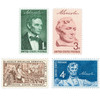
1958-59 Lincoln Sesquicentennial Series
# 1113-16 - 1958-59 Lincoln Sesquicentennial Series
$0.95 - $1.80
U.S. #1113-16
1958-59 1¢ Abraham Lincoln
1958-59 1¢ Abraham Lincoln
Four stamps were issued for the Lincoln Sesquicentennial Series. George Peter Alexander Healy's painting from life, "Beardless Lincoln," is pictured on U.S. #1113. The painting was completed in 1860, soon after Lincoln's election to the Presidency.
U.S. #1114 is based on a marble sculpture of Lincoln's head, by Gutzon Borglum in 1906. The sculpture sits in the Rotunda of the Capitol Building in Washington, D.C.
U.S. #1115 recalls the 1858 political debates between Abraham Lincoln and Stephen A. Douglas that made Lincoln a national figure.
The final issue in the Lincoln Sesquicentennial Series shows a drawing by Fritz Busse of part of the famous statue by Daniel Chester French, which stands in the Lincoln Memorial in Washington, D.C.
Abraham Lincoln – First President with a Beard
U.S. #1113 shows Abraham Lincoln without a beard – different from the more common bearded images. Lincoln was the first U.S. President to have a beard. He grew it after being elected, perhaps on the advice of an 11-year-old girl.
Grace Bedell, of Westfield, New York, wrote a letter to Lincoln on October 15, 1860, during the Presidential election that year, urging him to grow a beard. She told Lincoln he would be “much improved in appearance, provided you would cultivate whiskers.”
Young Grace further promised to convince her brothers to vote for Lincoln if he grew a beard. “You would look a great deal better as your face is so thin. All the ladies like whiskers and they would tease their husbands to vote for you and then you would be President,” she explained.
Lincoln was so amused by the letter that he wrote back to her four days later. “As to the whiskers, having never worn any, do you not think people would call it a piece of silly affectation if I were to begin now?” he wrote. However, between the election and the time he took office in March 1861, Lincoln grew the suggested beard. Later, as he traveled from Illinois to Washington, D.C., he stopped in Westfield and met Grace Bedell.
Other reasons for Lincoln’s new fashion may include concerns about his youth. At age 51, Lincoln was the youngest person elected President at the time, and may also have added the beard to suggest maturity.
U.S. #1113-16
1958-59 1¢ Abraham Lincoln
1958-59 1¢ Abraham Lincoln
Four stamps were issued for the Lincoln Sesquicentennial Series. George Peter Alexander Healy's painting from life, "Beardless Lincoln," is pictured on U.S. #1113. The painting was completed in 1860, soon after Lincoln's election to the Presidency.
U.S. #1114 is based on a marble sculpture of Lincoln's head, by Gutzon Borglum in 1906. The sculpture sits in the Rotunda of the Capitol Building in Washington, D.C.
U.S. #1115 recalls the 1858 political debates between Abraham Lincoln and Stephen A. Douglas that made Lincoln a national figure.
The final issue in the Lincoln Sesquicentennial Series shows a drawing by Fritz Busse of part of the famous statue by Daniel Chester French, which stands in the Lincoln Memorial in Washington, D.C.
Abraham Lincoln – First President with a Beard
U.S. #1113 shows Abraham Lincoln without a beard – different from the more common bearded images. Lincoln was the first U.S. President to have a beard. He grew it after being elected, perhaps on the advice of an 11-year-old girl.
Grace Bedell, of Westfield, New York, wrote a letter to Lincoln on October 15, 1860, during the Presidential election that year, urging him to grow a beard. She told Lincoln he would be “much improved in appearance, provided you would cultivate whiskers.”
Young Grace further promised to convince her brothers to vote for Lincoln if he grew a beard. “You would look a great deal better as your face is so thin. All the ladies like whiskers and they would tease their husbands to vote for you and then you would be President,” she explained.
Lincoln was so amused by the letter that he wrote back to her four days later. “As to the whiskers, having never worn any, do you not think people would call it a piece of silly affectation if I were to begin now?” he wrote. However, between the election and the time he took office in March 1861, Lincoln grew the suggested beard. Later, as he traveled from Illinois to Washington, D.C., he stopped in Westfield and met Grace Bedell.
Other reasons for Lincoln’s new fashion may include concerns about his youth. At age 51, Lincoln was the youngest person elected President at the time, and may also have added the beard to suggest maturity.












